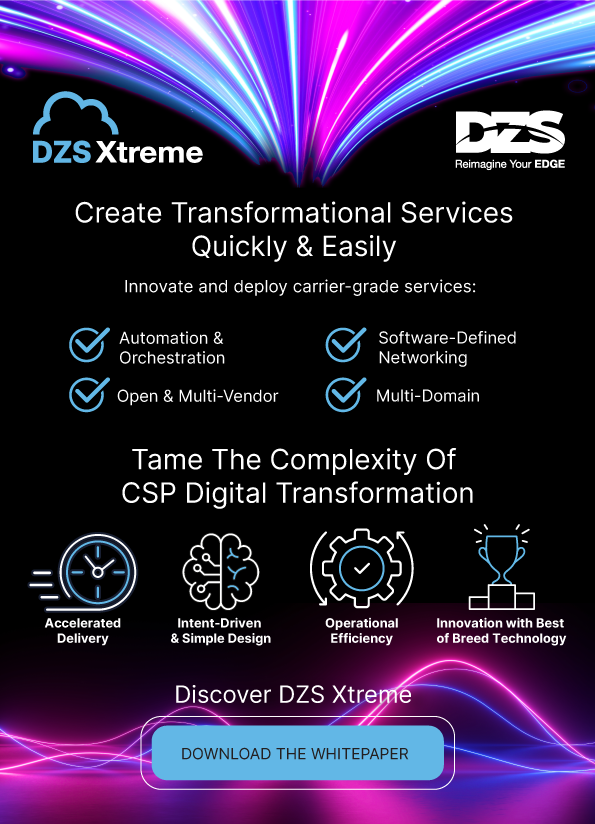As communications service providers pour unprecedented sums into advanced mobile and fixed network technologies there’s an ever more urgent question hanging over all that spending.
Namely, when will operators be able to generate returns on their investments that reflect utilization of network resources to their full potential? Or, to put it another way, when will they be able to escape the Hobson’s choice between operating in disparate network silos or sacrificing best-of-breed choices in favor of unification through vendor lock-in?
The answer might come as a surprise to many in an industry where operating in fixed and mobile network silos has been the norm since the dawn of cell service. As revealed in a new whitepaper from DZS, now is the time to break free of this paradigm.
Siloed operations and vendor lock-in are destined to disappear now that CSPs have access to a vendor-agnostic network management platform that can orchestrate accelerated development and activation of any type of service across all types of fixed and mobile networks. Or, as the whitepaper title puts it, “The Ultimate Guide to Automated, Multi-Domain Service Orchestration.”
The Case for a Brighter Outlook
The whitepaper describes how, for the first time, CSPs can attain the full ROI potential of unified network operations through implementation of the DZS Xtreme multi-network orchestration platform. Along with exploring the technological underpinnings and capabilities of Xtreme, the document explains what’s at stake for CSPs as the world transitions to reliance on cloud-based applications and services.
The whitepaper surveys a decade of disappointing industry returns to investors amid declining ARPU and cites research projecting more of the same under current conditions. But it makes clear how wrong such expectations could be by pinpointing major opportunities for CSPs who can counter the ARPU-draining impact of cloud-based super-scalers encroaching on everything from IPTV and smart home consumer services to value-added services in the SMB and large enterprise markets.
Recognizing there’s no putting the OTT genie back in the bottle, the whitepaper lays out the potential for new business models open to CSPs who put their orchestrated network resources to work in revenue-generating partnerships spanning multiple service categories. Here the upside lies with providing the network support cloud app providers need in order to deliver far more compelling user experiences than they can offer through reliance on unmanaged internet connections with their customers.
The prospects for CSPs are transformative. With the alacrity to quickly spin up new applications and services for cross-platform distribution, they alone can deliver the functionality, reliability, quality, and security consumers and businesses are looking for on all devices at all access points.
The Xtreme-Based Paradigm Shift
Xtreme makes this possible in its role as the network orchestration component of the DZS Cloud Edge portfolio of software-defined solutions. The platform can be deployed independently or to even greater effect in tandem with Expresse and CloudCheck, which are the Cloud Edge components operators can use to automate customer-centric approaches to meeting QA and other UX goals across external and on-premises infrastructures. These solutions are the subject of the whitepaper titled “The Cloud-Orchestrated Path to CSP Ascendancy in the Emerging Metaverse.”
The new whitepaper explains how Xtreme exploits industry-wide adoption of open standards with reliance on workflows modeled on standardized data templates to enable highly automated control over all network elements in the access, mobile, and transport network domains. This includes all elements that rely on SDN- or NFV-based execution of functionalities. And in cases where proprietary systems that aren’t standards-compliant are involved, operators have recourse to plug-ins developed by DZS to support integrations with Xtreme.
Of special note, the whitepaper points out that with the rapid movement of the industry toward adoption of NFV technology, DZS has ensured CSPs will be able to take full advantage of every incremental step in this direction with public, private or hybrid operations on cloud infrastructure. Over 90 network functions from 50 different vendors are catalogued in the Xtreme NFV system, including support for all the virtualized use cases documented for the consolidation of NFV with SDN technology through SDNFV.
Across all domains, Xtreme employs its workflow models in conjunction with object-based abstractions of standards-defined network element functions to configure the use of resources like Lego building blocks. This enables automated execution of whatever sets of functions are needed to deliver services mapped to customer-defined needs in any market segment. Every user-stipulated task can be fulfilled through drag-and-drop activation of wizard-driven operations on the multi-layered Xtreme UI.
Automating a New Realm of Capabilities
Among the many benefits to CSP operations enumerated by the whitepaper are the rapid adjustments in optical access and transport operations that can be executed with the ground-breaking performance capabilities enabled by the DZS Velocity V6 OLT and DZS Saber 4400 coherent optical transport platform. Velocity V6 can be used to serve anywhere from 20,000 to 20 million customers, while the Saber 4400 has redefined the economics of optical transport by expanding capacity to as much as 400 Gbps per wavelength with new levels of flexibility and scalability in an environmentally hardened form factor. In both cases, automated management through Xtreme maximizes operators’ ability to exploit the dynamic versatility intrinsic to these platforms.
The whitepaper also describes how Xtreme facilitates consolidation of the design and implementation of service verticals on a single platform by replicating 5G slicing through advanced spectrum management techniques on optical and copper links. This makes it possible to assign bandwidth to specific services across the entire CSP footprint.
The whitepaper explains how Xtreme architecture accounts for everything that’s essential to maximizing automation. For example, once the Xtreme platform has been integrated with a CSP’s OSS, BSS, and specialized systems like CRMs and service assurance tools, interactions with those components remain stable without the need for further integrations as services, use cases and suppliers change.
Xtreme also automates service assurance across all network domains via integration of Closed Control Loop (CCL) scaling and healing processes into all workflows. Cross-domain correlation of monitoring information hierarchies related to service components, segments, and topology ensures any issues affecting SLA performance are addressed in all instances.
Comprehensive automation is also facilitated by the fact that transitions within and among the model-based workflows are encoded to minimize or eliminate the need for custom scripts. And when it comes to accelerating development of new applications and services, Xtreme sharply reduces coding requirements by enabling the same designs to be replicated across multiple use cases, network infrastructures, and clouds.
As the whitepaper notes, the only aspects to life-cycle management of network resources that require manual execution when Xtreme is in play are the planning processes associated with instantiating new network resources and launching new services.
Results Propel Growing Use of Xtreme in All CSP Scenarios
In light of all these capabilities, the whitepaper leaves no doubt that network operators deploying Xtreme have found the key to driving ARPU growth with the tight rein on TCO that’s essential to ensuring robust ROI. This is a path to success open to every type of CSP, from incumbents and regional independents to utility- and municipality-administered operations.
Operators who have invested in 5G infrastructure are finding they can quickly and cost-effectively extend any new 5G services suited for wireline access across their fixed network footprints. And they can easily extend services offered over wired infrastructure into their mobile and FWA domains.
The whitepaper cites the experiences of Canadian Tier 1 operator Telus as one example of what operators can expect when they put Xtreme to work. In this case, Xtreme is facilitating aggressive use of NFV in a major transition to cloud-based support for 5G services. Quoting Telus CTO Ibrahim Gedeon, the whitepaper reports that the company has seen a 3X to 4X acceleration in the onboarding of new services and delivery of new features.
The picture painted by this whitepaper is clear. From now on, ever more CSPs will be taking advantage of Xtreme to enable automated orchestration of best-of-breed network components across all network domains as they follow consumer and business market demand wherever it leads.
Download the whitepaper, “The Ultimate Guide to Automated, Multi-Domain Service Orchestration,” to learn more.



